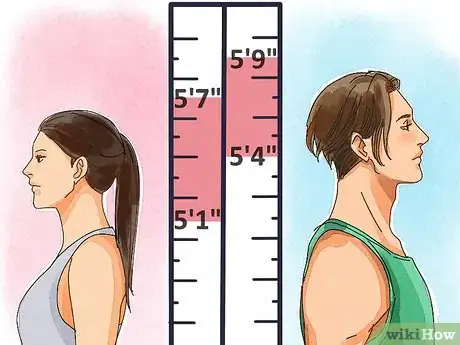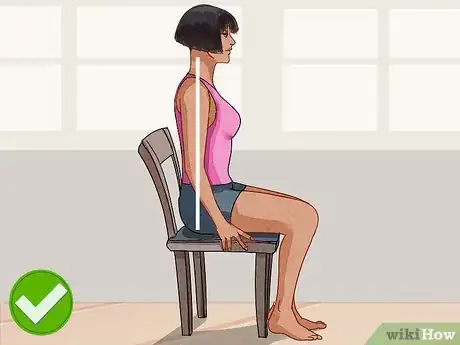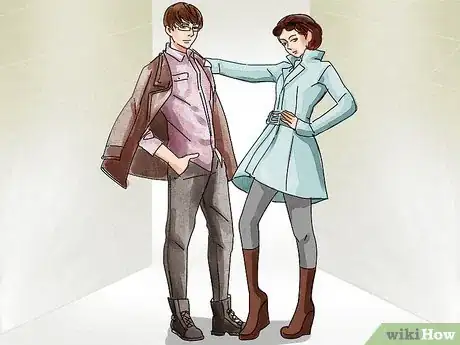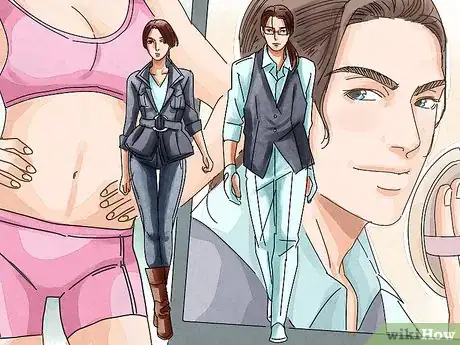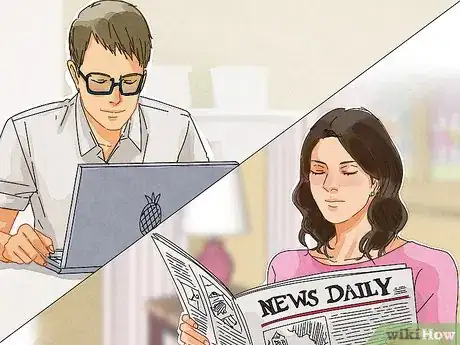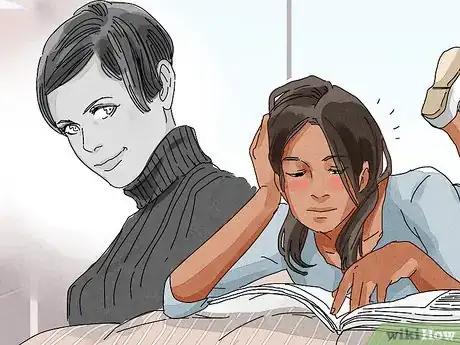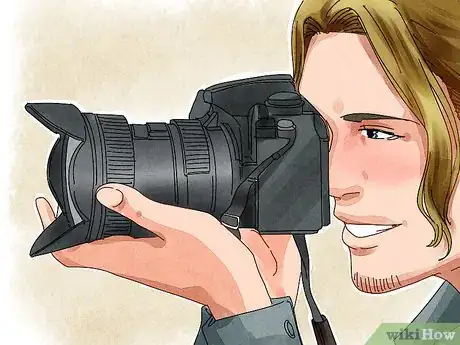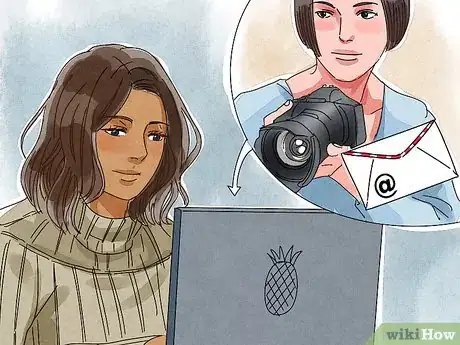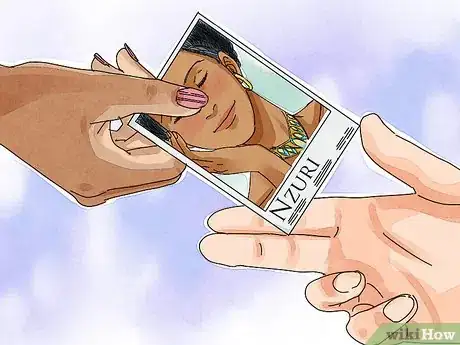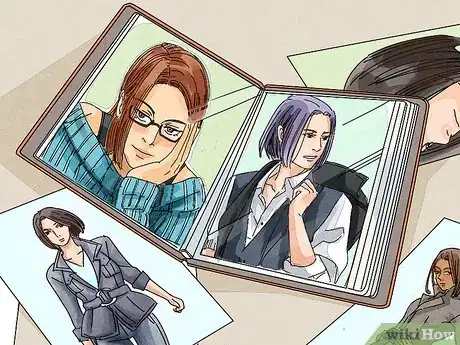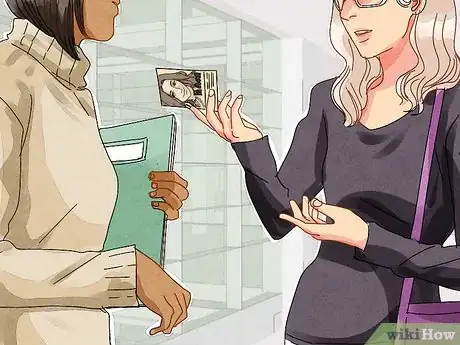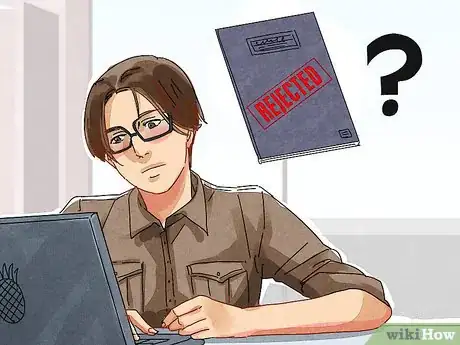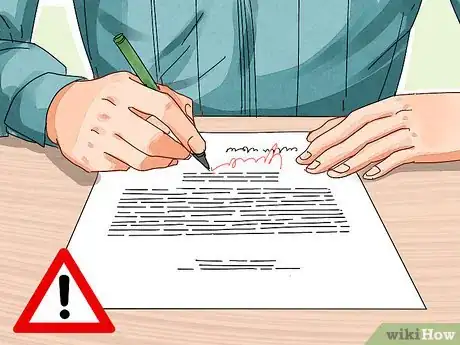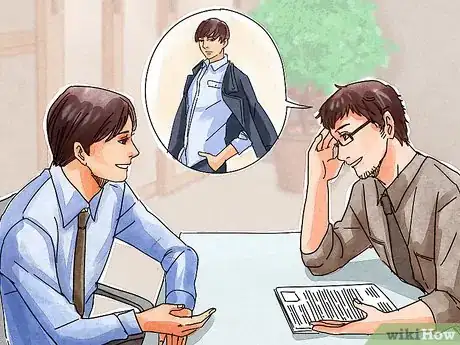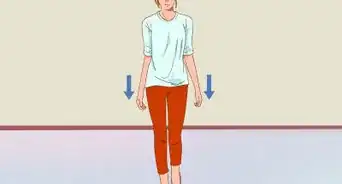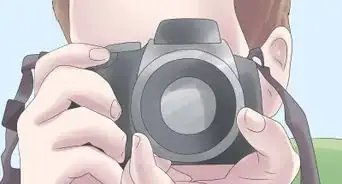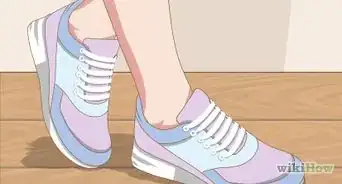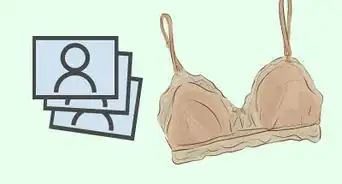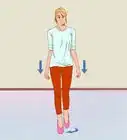This article was co-authored by Melynda Choothesa. Melynda Choothesa is a Costume Designer, Wardrobe Stylist, and Art Director with over 10 years of fashion consulting experience. She has worked on creative direction for fashion shows, costume design, and personal wardrobe styling, both in Los Angeles, California and internationally for clients such as Akon, Kathy Ireland, and Aisha Tyler. She has an Associate of Arts in Fashion Design from Santa Monica College.
There are 10 references cited in this article, which can be found at the bottom of the page.
This article has been viewed 301,877 times.
Petite modeling is a growing industry. A shorter height should not stand in your way of becoming a model. You have a chance at becoming a model if you are professional, ambitious, and possess a unique look. To begin the process of becoming a petite model, you should analyze your looks, research the industry, have professional photos taken, and finally, find an agency.[1]
Steps
Petite Model Requirements
-
1Make sure that you fit into the petite height category. You have to be between specific heights for the petite modeling industry. For women, you should typically be no taller than 5’7”, but your height should be above 5’1”. Men should be between 5’4” and 5’9”. The preferred heights may vary depending on the agency and/or agent. [2]
-
2Recognize your best features. Look at your features honestly. Choose at least one feature that stands out and is often complimented, such as your eyes, smile, or legs. Try to draw attention to that feature. This can be done by wearing makeup, or wearing clothing that accentuates that feature. [3]
- Wear flattering eye makeup if your eyes are your most complimented feature.
- Wear form-fitting pants or leggings if your legs are your best feature.
- If you are having trouble choosing a feature, ask friends what they first noticed about you upon meeting you.
Advertisement -
3Practice good posture. Good posture makes you appear even taller than you are. This can allow you to get noticed even around taller models. Practice sitting with a straight spine, and keep your shoulders back when walking.
-
4Work on personal style. A stylist and photographer will alter your appearance for photo shoots, but that doesn’t mean you shouldn’t have a strong sense of personal style. Decide if you are girly, alternative, earthy, punk, etc. Showing off your personality through your appearance can draw attention to yourself, and lead people to focus on something other than your height.
- Wear clothing that sets you apart from the crowd. Don’t be afraid to divert from popular fashion.
- Try out a hair cut and color that flatters your face and gives you a distinct appearance.
Doing Your Research
-
1Acknowledge your modeling opportunities. Opportunities to become a high fashion runway model are not impossible, but they are limited. Modeling for magazines, catalogs, and print ads are your best options for petite modeling. Specifically, consider parts, swimsuit, lingerie, and commercial modeling.[4]
- Parts modeling involves modeling specific body parts like hands, feet, teeth, and eyes. Height does not matter for this type of modeling, as long as you meet the aesthetic requirement for the desired body part.
- Body type matters more than height for swimsuit modeling. A fit and curvaceous body is desired more than a tall height for women in swimsuit modeling. For men, a fit and athletic body is more important than height.
- Many modeling agencies are looking for models with all different body types, not just models who fit into smaller sizes.[5]
- Lingerie and underwear modeling have similar requirements to swimsuit modeling. The women should be fit and curvaceous, and the men should have an athletic figure. The model being comfortable with his or her body is important in this type of modeling.
- Commercial modeling is aimed towards selling products. These products might be jewelry, cosmetics, cars, etc. The average height for a female commercial model is 5’4”, and a male commercial model is around 5’9”. Commercial modeling is a great field for petite models because the aim is to sell a lifestyle, and models of all ages, sizes, and ethnicities are sought after.
-
2Browse potential publications. Look for publication that you would like to be in someday. This will give you an idea of the types of jobs to pursue. Remember, that high fashion modeling may be difficult to pursue, so look for publications that show off petite models.[6]
- Local magazines and newspapers are good places to start modeling. Pick up local publications and browse through their advertisements.
-
3Choose a role model. There have been quite a few famous models that didn’t even reach 5’8”. Some of these models are Devon Aoki (5’5”), Eva Pigford (5’5”), Twiggy (5’6”), and Kate Moss (5’7”). These women have walked the runway and modeled for print publications. A few of them, like Twiggy and Kate Moss, are some of the most famous models in history. A short stature may make modeling success more difficult, but it’s not impossible.
-
4Be in the right location. Find out whether or not your city is a good location for petite modeling. If there are few agencies in the area, you might need to relocate to a bigger city. You may only need to relocate if you desire to become a part of a larger agency, or in an area with a lot of opportunities. If you only want to do commercial modeling, a smaller city could yield enough opportunities.[7]
- At this point, you should only consider making a move. Do not move until you have a portfolio, and you are confident that you will be successful enough to maintain a living by modeling.
Getting Professional Photos Taken
-
1Find a photographer. You will need to at least have some headshots taken. Look for photographers in your area that have done photo shoots with models in the past. Remember that having photos taken can be expensive, so make sure you have enough money set aside for a photo shoot. If you are on a budget, you may find a photography school with students willing to take pictures for free to build their portfolios.[8]
- Browse the website of photographers in your area. It is important that you see their work before hiring them to take photos.
-
2Contact photographers whose work you admire. If you see inspiring pictures in a magazine or catalog, find out who the photographer is and try get in touch. He or she might be interested in taking your picture, especially if he has new creative ideas for which he needs a model. This may be limited only to photographers in your area, however. Famous photographers will probably not have the time or incentive to respond.[9]
- Send a polite email or social media message. Do not harass the photographer with repeated messages if he or she does not respond.
-
3Make a comp card. A comp card, or composite card, is a marketing tool used by models for self-promotion. This is akin to a business card that you can send to agencies interested in petite models. A comp card allows industry professionals to judge you based off of more than just a headshot. This is what your agent would send in to submit you for print work. It should have a headshot on the front, three to five photos on the back, and your measurements. A good size for a comp card is 6”x 9”.[10]
- For a comp card, you should have photos showing you from every angle. Have one photo showing you facing the camera directly, and a few photos taken of you from various angles. It is also a good idea to include one or two candid photos.
- Examples of comp cards can be found in a quick online search.
- If you are a parts model, or a model that only shoots specific types of photos, then you will not need a typical comp card. Include photos of body parts if you are a parts model. Include photos of you in swimsuit or lingerie if you plan to be a swimsuit or lingerie model.
-
4Put together a portfolio of your best pictures. This is a big book of photos that you will bring with you when seeking an agency or petite modeling gig. Superior photos can override a shorter height in the modeling industry, so make sure that you only include your best photos. Your portfolio will grow larger and change over time as you gain more experience.[11]
Finding an Agency
-
1Research agencies that have signed petite models. Research each agency that you are interested in to ensure that they have signed successful petite models. Many agencies let aspiring models know who they have signed in the past, though you can also search for the agency name online to find out more. Focusing on agencies that are interested in petite models will heighten your chances of finding work.[12]
-
2Go to open calls for modeling agencies. Open calls are times when new models can visit a modeling agency to find out if anyone is interested in representing them. This is a good way to find potential representation if you do not yet have an agent. You can look for local calls, or choose to travel to attend an open call. Though it depends on the agency’s requirements, typically you will need to bring a headshot, comp card, and a swim suit.[13]
- Open calls usually attract a lot of other aspiring models. Don’t be disappointed if nothing comes from your first few open calls.
- Make sure to dress nicely, be on time, be able to accept criticism, and have a working phone number if the agency decides to call you back.
- Being polite and professional will increase your chances of being selected.[14]
-
3Ask questions when you are rejected by an agency. Find out if there is something you can change to get accepted in the future. Some agencies may not want to answer questions, so do not push your questions if the agency is not willing to comply.
- Send an email or thank you letter to the agent. Even if you are rejected, it is a good idea to send an email thanking the agent for taking his or her time to meet with you. The note or email should be short and thank them for their time. You never know when you will encounter this person in the future, so it is good to leave the person with a pleasant memory of you.
-
4Think it through before signing with an agent. Sign with the agent that seems most interested in you and offers the most opportunities. Make sure the agency can further your career before you commit to it. This may mean looking up reviews for the agency on the internet, asking others in the industry, and seeing if they have any successful clients.[15]
- Be sure to review the contract carefully before signing it. Don’t make a commitment that you can’t stick with.
- It's important to be upfront about your boundaries and expectations before you sign anything.[16]
-
5Attend any go-sees that your agency sets up. Go-sees are meetings with professionals in charge of fashion shows, magazines, and catalogs. These are very important because they are what determines if you get a job. Go to every go-see that your agency books for you to elevate your chances of finding a job. What you do and what you wear to a go-see depends on the requirements of your agency, and the company you are meeting with.[17]
- Never do anything during a go-see that makes you uncomfortable. A job is not worth risking your safety or personal values.
Expert Q&A
Did you know you can get expert answers for this article?
Unlock expert answers by supporting wikiHow
-
QuestionWhat are some of the qualities that the best models have?
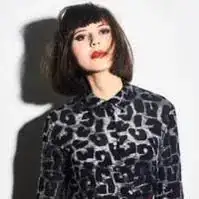 Melynda ChoothesaMelynda Choothesa is a Costume Designer, Wardrobe Stylist, and Art Director with over 10 years of fashion consulting experience. She has worked on creative direction for fashion shows, costume design, and personal wardrobe styling, both in Los Angeles, California and internationally for clients such as Akon, Kathy Ireland, and Aisha Tyler. She has an Associate of Arts in Fashion Design from Santa Monica College.
Melynda ChoothesaMelynda Choothesa is a Costume Designer, Wardrobe Stylist, and Art Director with over 10 years of fashion consulting experience. She has worked on creative direction for fashion shows, costume design, and personal wardrobe styling, both in Los Angeles, California and internationally for clients such as Akon, Kathy Ireland, and Aisha Tyler. She has an Associate of Arts in Fashion Design from Santa Monica College.
Fashion Designer
-
QuestionHow do you get your name heard for petite modeling?
 Community AnswerYou will need to gain experience to get your name out their as a model. Get photos taken, find an agency, and begin working. It is also good to share your work on social media.
Community AnswerYou will need to gain experience to get your name out their as a model. Get photos taken, find an agency, and begin working. It is also good to share your work on social media. -
QuestionDo petite models need to a certain body size or shape?
 Community AnswerModels come in all shapes and sizes. Unfortunately, the industry typically leans towards thinner models for high fashion, but commercial models can be curvy. There is a place for any type of body.
Community AnswerModels come in all shapes and sizes. Unfortunately, the industry typically leans towards thinner models for high fashion, but commercial models can be curvy. There is a place for any type of body.
Warnings
- Do not develop an eating disorder in the process of becoming a petite model. Beauty comes in all shapes and sizes. Trying to lose weight to achieve a certain look is not worth risking your health.⧼thumbs_response⧽
- Only do what makes you comfortable. Leave immediately if a photographer, agency, or company asks you to do anything inappropriate that makes you feel uncomfortable.⧼thumbs_response⧽
References
- ↑ http://www.ukmodels.co.uk/petite-modelling-height-and-work/
- ↑ https://www.modelscouts.com/petite-models
- ↑ https://www.modelscouts.com/petite-models
- ↑ https://www.thebalance.com/how-smaller-models-can-break-into-the-industry-2379346
- ↑ Melynda Choothesa. Professional Stylist & Fashion Designer. Expert Interview. 17 April 2019.
- ↑ http://www.ukmodels.co.uk/petite-modelling-height-and-work/
- ↑ http://www.ukmodels.co.uk/petite-modelling-height-and-work/
- ↑ http://www.ukmodels.co.uk/petite-modelling-height-and-work/
- ↑ http://www.ukmodels.co.uk/petite-modelling-height-and-work/
- ↑ https://www.jordanmatter.com/photography/comp-cards/what-is-a-comp-card
- ↑ http://www.ukmodels.co.uk/petite-modelling-height-and-work/
- ↑ http://www.ukmodels.co.uk/petite-modelling-height-and-work/
- ↑ https://www.thebalance.com/modeling-agency-open-calls-2379488
- ↑ Melynda Choothesa. Professional Stylist & Fashion Designer. Expert Interview. 17 April 2019.
- ↑ http://www.ukmodels.co.uk/petite-modelling-height-and-work/
- ↑ Melynda Choothesa. Professional Stylist & Fashion Designer. Expert Interview. 17 April 2019.
- ↑ http://www.newmodels.com/works.html
- ↑ http://www.ukmodels.co.uk/petite-modelling-height-and-work/
- ↑ https://www.thebalance.com/modeling-agency-open-calls-2379488
- ↑ https://www.thebalance.com/modeling-agency-open-calls-2379488
About This Article
You don’t have to be tall to become a model, as petite models have a unique place in the industry too. First, check that your height is within the requirements set by agencies to do petite modeling. Although the heights can differ between agencies, petite model women are typically between 5’1” and 5’7”, while petite model men are generally between 5’4” and 5’9”. Next, create a portfolio of your best pictures to give to potential agencies. Get some professional photos taken that best represent you and your brand and compile these into a big album. Finally, attend open calls that are run by modeling agencies to potentially find an agent to represent you. When you attend the open call, put your best foot forward and be open to constructive criticism to increase your chances of getting a callback. For more tips on becoming a petite model, like how to choose the best location to model in, read on.
